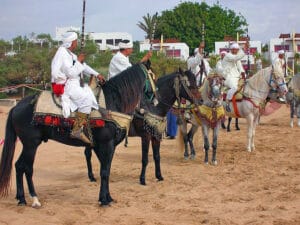The Barb is native to Northwest Africa’s Maghreb region, and MATHILDE GREGOIRE explores their fascinating story.
The Barb or Berber horse originates from the cradle countries of Algeria, Morocco and Tunisia, formerly known as the Barbary Coast and from which the breed takes its name. Known for their hardiness and stamina, the Barb has for centuries been bred for farm work, hunting, wars, and parades. A striking saddle horse that excels at endurance, their bloodlines can be traced to many other breeds across Europe and the US.
A long history
Archeologists discovered evidence to suggest that the Barb has been native to North Africa for over 3,000 years. Traditionally, they lived closely with the region’s nomadic Berber tribes. When the North African Moors invaded Spain in the 8th Century, they took their horses with them, spreading the bloodline through Europe’s native breeds and creating the foundations for Thoroughbreds, Andalusians and Lusitanos.
Barb horses were later introduced to the Americas by Spanish explorers in the early days of settlement, fundamentally influencing and shaping many American breeds, including the Quarter Horse, Criollo, and Paso Fino, all of which inherited the Barb’s compact build, strength, agility, and intelligence.

A Barb horse in traditional Tbourida harness.
In 1987, the World Organization of the Barb Horse (WOBH) was founded. Headquartered in Algeria, this NGO unites countries in Northwest Africa’s Maghreb region, including Morocco and Tunisia, as well as several European nations, with the aim of safeguarding and supporting the breed, which in some areas has come close to extinction. Following this initiative, in 1989 France created its own studbook, the Association Française du Cheval Barbe, as a sub-branch of WOBH.
In 2003, Morocco stepped forward with the Royal Equestrian Society – Société Royale d’Encouragement du Cheval (SOREC). Endorsed by the Kingdom of Morocco, its purpose is to drive interest in the country’s equestrian cultural identity and to promote its native breeds. This initiative was successful in preserving the Barb heritage, with numbers doubling between 2011 and 2017.
Today, the Barb is bred primarily in northern African countries, as well as Spain and France, where they remain the most popular for trekking, endurance, and pleasure
riding. At the 2014 Alltech FEI World Equestrian Games held in Normandy, France, the Barb was showcased as Horse of Honor in the opening ceremony, also appearing in several displays held during the games.
The breed features in several Maghreb cultural traditions, including Tbourida, also known as the Festival Fantasia, an equestrian tradition dating back to the 16th Century in which cavalry charges by Arab and Berber warriors are re-enacted. Represented in many festivities and wedding celebrations, Tbourida is included in UNESCO’s Lists of Intangible Cultural Heritage as important to Morocco’s cultural identity.
Characteristics

Barbs have a long association with the nomadic Berber tribes of the Maghreb region.
Few breeds in the world, perhaps with the exception of the Arabian, posses the Barb’s level of stamina and endurance. Standing at an average height of between 14.2hh and 15.2hh, the Barb has a straight or slightly convex profile, high withers, thin but strong legs, and a powerful chest. They have round hindquarters, and unlike the Arabian, have a low-set tail. The most common coat colors are grey, black, and bay.
These desert horses are exceptionally sturdy and well-adapted to their harsh environment. Although the northern African region records high temperature ranges, they can withstand the extreme dry heat of the day, and windy, cold nights. Able to travel great distances with little food or water, the Barb is surefooted, calm and courageous. While they excel at speed and long-distance riding, they also possess qualities perfect for trail riding.
The Barb’s exceptional temperament, combined with its strength and stamina, has made the breed popular in France, where it often comes into its own in equestrian tourism and endurance races. One of the notable genetic characteristics of the Barb is that, much like the Arabian, it possesses five lumbar vertebrae instead of six. Researchers believe that this characteristic gives both breeds an advantage when it comes to endurance and stamina.

The Barb’s compact build, strength, agility, and intelligence have made it a popular under saddle (Image courtesy Association Française du Cheval Barbe).
Arab-Barbs
While there are now a number of sub-breeds including the Moroccan Barb, the West African Barb, Tunisian Barb, Algerian Barb, Spanish Barb, French Barb and Abaco Barb, perhaps the most popular is the Arab-Barb cross. While it is no surprise that many characteristics are shared across both breeds, and a clear genetic link between the two has been established, it is not known whether the Barb appeared before the Arabian, or whether they share a common ancestor.
Despite having influenced many breeds around the world, the Barb is not as popular as the Arabian. Considered by many as a less attractive horse, the Barb has often been crossed with Arabians to achieve greater elegance. Combining the qualities of the Barb, including agility, hardiness and stamina, with the Arabian’s fitness and elegance, the Arab-Barb makes for a popular saddle breed.
Visit the Royal Equestrian Society of Morocco and Aramco World to learn more about Barbs and Arab-Barbs.
Feature Image: A performance of the Tbourida at the annual Tan-Tan Moussem Festival in Morocco (Image by Maxim Massalitin).



